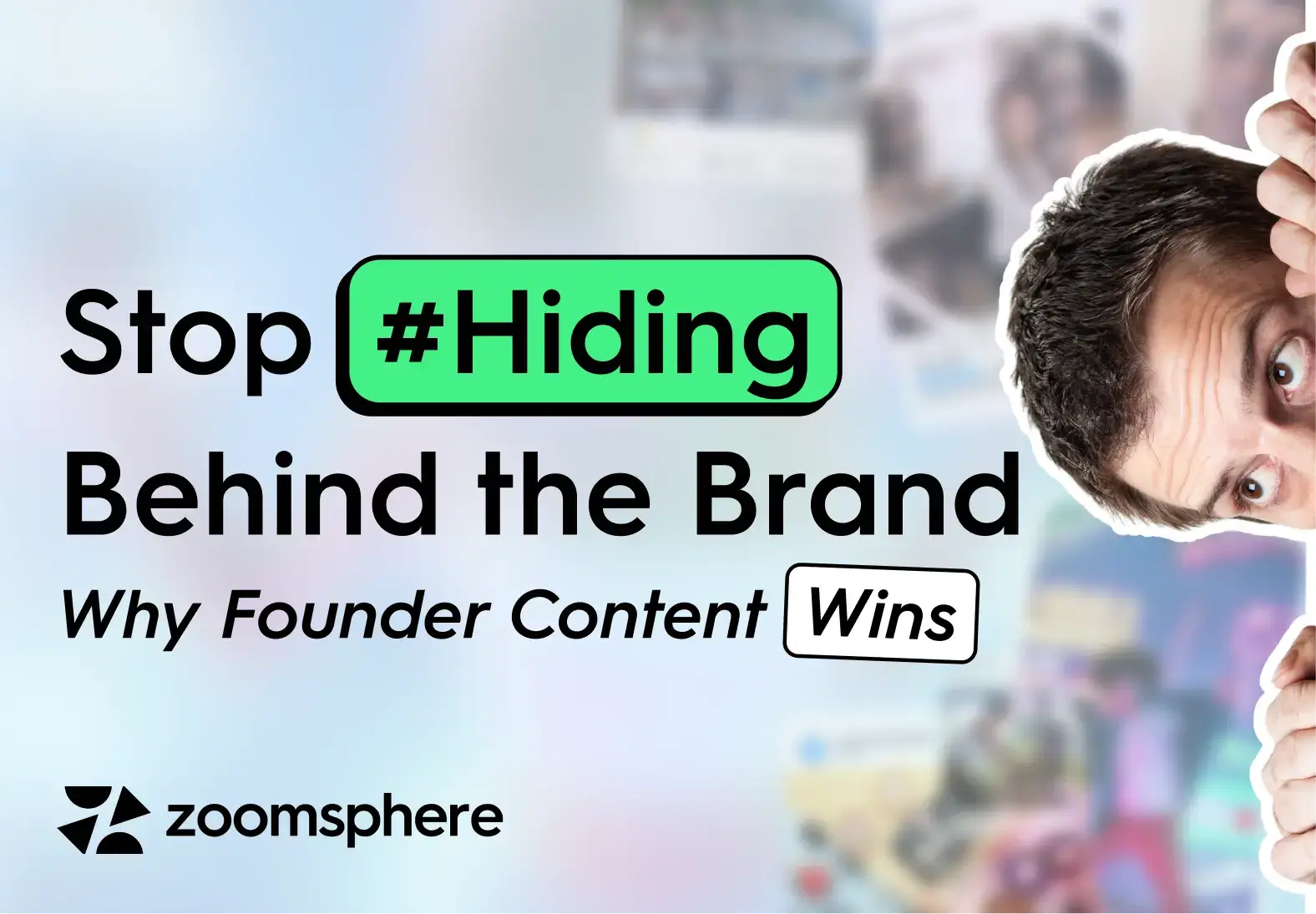Do People Follow the Brand—or the Person Behind It?

You’ve probably also seen it happen. A founder shares a shaky selfie and one mildly unhinged paragraph about nearly giving up in a grocery store parking lot. It racks up 60,000 likes. Meanwhile, the brand’s official post—four people, a bland infographic, and three hashtags—gets a sympathy retweet from the intern.
That’s personal storytelling eating your branded content strategy for breakfast. And it’s not even trying that hard.
Now, here’s the part that’s going to sting a little: your audience might know your company name, but they remember the person behind it. Statistically, literally—stories make a message 22 times more memorable than facts alone. And yet, we’re out here polishing “value propositions” like they mean anything to someone mid-scroll on a cracked iPhone.
Look… this isn’t a branding problem. It’s a visibility problem. More precisely, it’s a you’ve-removed-all-the-humans-from-the-equation problem.
Let’s talk about why your strategy isn’t broken—it’s just missing a pulse.
{{form-component}}
I Follow Elon, Not Tesla" — Why Humans Beat Logos Every Time
You can throw a million-dollar logo at someone and still get ignored.
Why?
Emotional storytelling triggers oxytocin, the trust-chemical that doesn’t give a damn about your serif typeface. When people hear a compelling personal narrative, their brains literally fall into rhythm with the storyteller’s. That’s called neural coupling—speaker and listener brainwaves lining up in real time, creating connection on a neurochemical level.
Stories don’t just stick; they anchor. A London Business School study found audience retention for narrative-based content hits 65–70%, whereas fact dumps linger at a dismal 5–10%.
“Marketing without narrative…”
…is like trying to caffeinate a room with stale air. It jolts nobody.
Calling your marketing “strategic” without someone learning who’s behind the curtain is window dressing, not connection. When you bury the person behind your brand, you eliminate the moisture marketing needs to remain relevant.
Why Humans Trample Logos Every Single Time
When you show a founder’s messy desk, a vulnerability-thread, or uncensored success failure, your audience sees a human, not a logo. And brains don’t form trust bonds with abstract brand assets—they bond with emotional triggers, mistakes shared, stakes revealed.
So yes, Tesla sells. But Elon Musk owns the feed. That’s how founder-led visibility becomes irresistible. People follow people, not faceless icons.
If marketers still believe branding means loyalty, they’re asleep at the wheel. Truth is, human resonance outruns brand symmetry every time.
The ‘Founder Effect’ Is Real. Here’s Why You’re Either Using It—or Losing Your Mind.
Founder storytelling drives reach and loyalty that corporate content can’t touch. Glossier wasn’t just Glossier—it was Emily Weiss with sleeves rolled up. Tesla without the guy naming his kids after cheat codes is just another EV company.
Founders who show up online make their brands feel alive. On LinkedIn, personal posts by founders and executives generate 2–3x the engagement of company page content. Because audiences connect with people (quirks, perspective, and stakes included) not a logo or a caption that sounds like it passed through six rounds of legal edits.
The Emotional Economics of Visibility
If you’re a CMO or CEO still hiding behind boilerplate updates, here’s the punch: 62% of B2B marketers confirm storytelling works, yet most are serving beige content while wondering why no one engages. Storytelling for CEOs has become a trust multiplier.
Behind the brand storytelling is where the emotional ROI lives. People want context, missteps, reflections. That’s what sparks loyalty and makes even mundane updates feel weighty. Strip out the human voice, and your engagement graph flatlines.
Now, here’s where strategy stops being a hunch. ZoomSphere now supports personal LinkedIn post analytics, so you can line up your founder’s raw, off-the-cuff post next to the polished brand feed and see which one’s actually paying the bills. Look: it’s never the stock-photo carousel.
When your founder’s voice drives authentic interaction, you’re not just feeding the algorithm—you’re creating mental real estate. Fail to use it, and someone else’s “less polished but more human” content will eat your relevance alive.
“But I’m Not Charismatic” — Says Every CMO Before Getting Outwritten by Their Intern
Charisma Is Overrated. Authenticity Pays.
Authentic storytelling doesn’t actually demand charisma. It demands honesty. Your audience isn’t grading your TED Talk potential—they’re scanning for proof that someone real exists behind the brand.
You don’t need to share your therapist’s notes. You don’t need a lighting crew. You need posts that don’t read like they were Frankensteined by AI and legal. If you’ve been outsourcing your voice to interns and scheduling your “personal” posts three months ahead, the numbers already show who’s winning.
{{cta-component}}
The 3 R’s of Personal Narrative Marketing
Your personal narrative marketing doesn’t need theatrics. It needs:
- Relatability – Speak to what your audience already lives. The humble product screw-up or the lightbulb moment in an airport lounge sticks harder than corporate fluff.
- Repetition – One viral post won’t carry your brand. Consistency compounds trust.
- Real Stakes – If nothing in your post matters to you, it won’t matter to anyone else.
This is a storytelling strategy personal enough to hook people without oversharing. It signals a human pulse, not a campaign calendar.
When your junior marketer’s authentic LinkedIn post triggers more engagement than the CMO’s perfectly staged update, it’s not luck—it’s a mirror. People follow voices, not job titles. Authentic storytelling scales because trust scales. Ignore that, and you’ll watch relevance quietly bleed out while your intern racks up DMs from your would-be clients.
Steal This (Actually Working) Framework — The VCR Method
If your brand feed feels like it’s written by a polite AI trying not to offend anyone, that’s your problem. Trust isn’t built by flaunting wins—it’s built by narrating the bruise under your brand hoodie. The campaigns that actually move people aren’t the polished ones—they’re the human ones.
As Marisa Lather, brand strategist and marketing voice, puts it:
%20(1)%20(1).webp)
And this is exactly what the VCR Method is built for.
Vulnerability: Start With the Bruise
The first “V” is Vulnerability—because people can’t connect with perfection. They connect with stakes. Share the product misstep. Admit the lesson you wish you’d learned sooner. This doesn’t require over-sharing or turning your feed into therapy—it just means you own the moment that nearly made you quit or forced a change in how you think.
Example: A SaaS CEO posting a candid reflection on why their last product update tanked will get 3–4x more engagement than a “Top 10 Features” list. Vulnerability signals authenticity.
Conflict: Show the Tension That Matters
Next, the Conflict—the part your audience leans in for. This is the friction or hard truth you confronted: the pushback from a client, the misread market signal, the brutal metric in your dashboard. Conflict is the human engine behind why personal stories matter—it creates a reason for people to care.
But conflict isn’t about drama for clicks. It’s about relatability. If your audience has faced the same tension, your post lives rent-free in their mind.
Resolution: Close the Loop With Meaning
Finally, the Resolution—but not the fluffy kind. Your resolution is what changed in your thinking, your team, or your process. A revenue spike is nice, but human takeaways stick longer than sales figures. This is where behind the brand storytelling builds trust and authority because people see that your perspective evolved, not just your ad spend.
How to Put VCR to Work (Without Burning 20 Hours a Week)
- Mine Internal Stories: Get your team to flag moments of real tension or insight—Slack threads, post-mortems, even customer feedback emails.
- Draft 1 VCR Post Per Month: One post that leans fully into Vulnerability, Conflict, and Resolution. Repurpose it across LinkedIn, email, and your brand site.
- Use ZoomSphere to Cross-Post and Measure: Schedule the VCR post across channels, then track engagement, shares, and CTRs with personal vs. brand account data side-by-side.
When you drop one high-quality VCR each month, it compounds. One post sparks DMs, another pulls speaking invites, another quietly drives signups. That’s personal narrative marketing with real ROI.
Because in 2025, you don’t win by being the loudest. You win by being the brand people actually believe.
The Modern Marketer’s Checklist: You’re Either Human, or You’re Muted
If your brand could disappear tomorrow and nobody would notice, it’s not a market problem—it’s a humanity problem. Today’s marketing battlefield doesn’t reward the most polished voice; it rewards the most real one. You can run ads until your credit card screams, but if buyers can’t feel who’s behind your logo, you’re invisible.
%20(1).webp)
Start With the Brutal Questions
Before you post another templated LinkedIn carousel, ask yourself:
- Is your founder known by name, or just a LinkedIn silhouette?
- Are your team’s personal wins public, or buried in a Slack thread no one outside your office will ever see?
- Does your analytics dashboard track personal channels, or only brand vanity metrics?
- Do you schedule story-led content as intentionally as product pushes?
- Can your audience sense an actual human heartbeat behind the feed?
If most of your answers land in the “uh, no” column, you’ve got a problem. Brands that hide their humanity forfeit trust. Marketers who delay storytelling in marketing pay in pipeline.
Stop Hiding Behind the Brand
Data doesn’t care about your fear of vulnerability. LinkedIn research shows that posts from founders and leadership often generate 2–3x more engagement than corporate page content. And yet, most marketing strategies still lean on boilerplate updates written like press releases that nobody reads.
This is where founder storytelling and personal storytelling strategy stop being “nice to have” and start being the price of entry. A CEO who shares the friction points, the stumbles, and the real insights doesn’t just earn attention—they earn trust, and trust converts.
What the Checklist Really Measures
This is the filter that separates brands that get scrolled past from brands that spark revenue. A modern marketing strategy can’t live on keyword stuffing and static graphics—it has to include:
- A visible founder presence that feels like a person, not a job title.
- Regular narrative posts from leadership and team members—not just campaign content.
- Story-led scheduling where the brand’s calendar prioritizes human-driven content alongside promotions.
- Integrated analytics that measure impact from personal and brand channels together.
If you can’t check all four boxes, you’re muted in the only conversations that matter.
Personal storytelling is no longer a branding exercise—it’s a survival strategy. Every week you wait to implement it, you’re compounding invisibility. Competitors who lead with human voices and real stakes will win by default.
So here’s your choice: stay faceless and forgettable, or commit to behind-the-brand storytelling that moves pipelines and people. Because in 2025, the algorithm isn’t your enemy. Your invisibility is.
{{form-component}}
What Happens If You Refuse to Lean In
If personal storytelling makes your skin itch, that’s fine. Just know the algorithm doesn’t care. It rewards faces, voices, flaws, and half-baked anecdotes over your perfectly manicured brand sheet—and it’s not even close.
Here’s the part no one likes to say out loud: brands that cling to “polished professionalism” as a shield are bleeding relevance to smaller competitors who hit record on a messy day. Not louder. Just more real.
You built equity. Good. But now you’re whispering in a room where everyone else brought a throat mic and a founder willing to talk about their third panic attack. They’re not oversharing. They’re owning the room.
Every quarter you delay personal content is a quarter you're forgotten faster. Your post calendar might be full, but if no one sees themselves in it, it’s white noise in a nicer font.
ZoomSphere gives you the tools to track the difference. Personal vs brand. Post vs presence. Strategy vs performance. All lined up, side by side. Just actual numbers, from tweet to thread to feed.
Because pretending the face doesn’t matter… is exactly what’s making you invisible.












Heading 1
Heading 2
Heading 3
Heading 4
Heading 5
Heading 6
Lorem ipsum dolor sit amet, consectetur adipiscing elit, sed do eiusmod tempor incididunt ut labore et dolore magna aliqua. Ut enim ad minim veniam, quis nostrud exercitation ullamco laboris nisi ut aliquip ex ea commodo consequat. Duis aute irure dolor in reprehenderit in voluptate velit esse cillum dolore eu fugiat nulla pariatur.
Block quote
Ordered list

- Item 1
- Item 2
- Item 3
Unordered list
- Item A
- Item B
- Item C
Bold text
Emphasis
Superscript
Subscript



.webp)


%20(1).webp)
%20(1).webp)
.webp)

